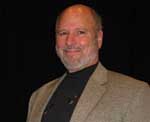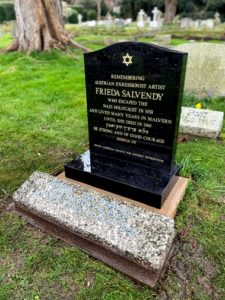By Jerry Klinger

MALVERN, England — An important Holocaust memory was completed, interpreted, this week, not just for today but for a hundred years or more of tomorrows.
A permanent interpretive headstone was placed for an Austrian Jewish woman, a refugee, who died and was buried far from her homeland in an obscure English churchyard cemetery under a Star of David. Her only marker before was a simple footstone with her name.
The Jewish American Society for Historic Preservation (JASHP) had arranged for a historical interpretive marker to be placed on the Malvern old age home where Frieda Salvendy died. The interpretive marker on the entrance wall will endure, perhaps for a few decades before time and change will have it removed. Frieda’s story will recede into the gray mist.
Frieda’s story is more than she was a groundbreaking Austrian Expression artist who fought the dominance of the male-centered art world. Her accomplishments as an artist and a women’s rights fighter were significant.
But her story needed more context. It needed more understanding.

Frieda fled the land of her birth because she was a Jew. She was forced to escape the clutching death that the Nazis brought to all Jews in their grasp. It was a time of Jewish disaster when 6 million Jews were murdered by German Nazis and their ardent antisemitic supporters across Europe, the Holocaust.
Today, less than 40% of people have heard of the Holocaust or know what it was. What will the numbers of memory be in 100 years?
Cemeteries endure for centuries, especially when associated with ongoing church communities.
Frieda Salvendy was buried in the Malvern Church Cemetery even though she was a Jew. Surprisingly, it is more common than many assume. Without a Jewish identifier, a star on a tombstone or the word Jewish, few know, and no-one will know, the interred was Jewish.
Placing a tombstone with a Star and or the word Jewish will be a curiosity of memory to future cultural visitors coming across the gravesite in the Christian cemetery. They will stop and wonder who this person was and understand the why she is here.
This week, JASHP completed, with the cooperation of the Church community, a new interpretive headstone for Frieda Salvendy sited above her resting place. It is more than a tombstone. It is a story of memory, of education, of understanding of tragedy and shelter. Frieda, fortunately for her and unfortunately for too many others, found safety and shelter in the U.K. during the Holocaust.
One hundred years, 200 years from now, a visitor will read who Frieda was. Perhaps they will ask what was the Holocaust? Her memory, a tiny story in the enormous tragedy of the darkness, will be remembered.
Cemeteries are not just places of mourning. For many who visit, they are also outdoor museums, cultural windows to the past that have shaped who and what we are today.
*
Jerry Klinger is the President of the Jewish American Society for Historic Preservation, www.JASHP.org.